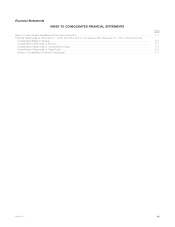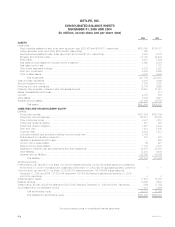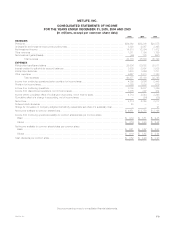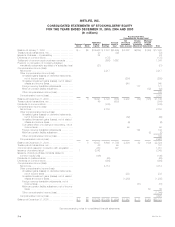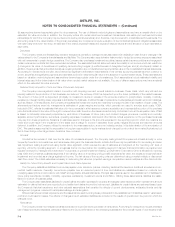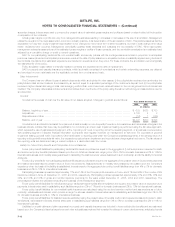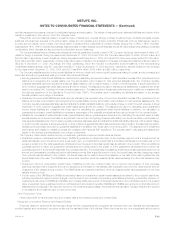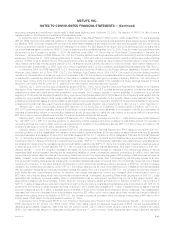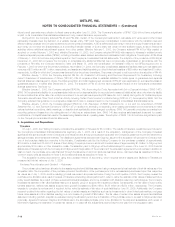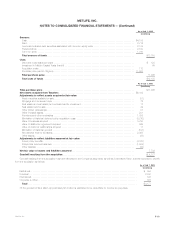MetLife 2005 Annual Report Download - page 72
Download and view the complete annual report
Please find page 72 of the 2005 MetLife annual report below. You can navigate through the pages in the report by either clicking on the pages listed below, or by using the keyword search tool below to find specific information within the annual report.METLIFE, INC.
NOTES TO CONSOLIDATED FINANCIAL STATEMENTS — (Continued)
Impairment losses are based upon the estimated fair value of real estate, which is generally computed using the present value of expected future cash
flows from the real estate discounted at a rate commensurate with the underlying risks. Real estate acquired upon foreclosure of commercial and
agricultural mortgage loans is recorded at the lower of estimated fair value or the carrying value of the mortgage loan at the date of foreclosure.
Policy loans are stated at unpaid principal balances.
Short-term investments are stated at amortized cost, which approximates fair value.
Other invested assets consist principally of leveraged leases and funds withheld at interest. The leveraged leases are recorded net of non-recourse
debt. The Company participates in lease transactions which are diversified by industry, asset type and geographic area. The Company regularly reviews
residual values and impairs residuals to expected values as needed. Funds withheld represent amounts contractually withheld by ceding companies in
accordance with reinsurance agreements. For agreements written on a modified coinsurance basis and certain agreements written on a coinsurance
basis, assets supporting the reinsured policies and equal to the net statutory reserves are withheld and continue to be legally owned by the ceding
companies. Other invested assets also includes derivative revaluation gains and the fair value of embedded derivatives related to funds withheld and
modified coinsurance contracts. The Company recognizes interest on funds withheld in accordance with the treaty terms as investment income is earned
on the assets supporting the reinsured policies. Interest on funds withheld is reported in net investment income in the consolidated financial statements.
The Company participates in structured investment transactions, primarily asset securitizations and structured notes. These transactions enhance
the Company’s total return on its investment portfolio principally by generating management fee income on asset securitizations and by providing equity-
based returns on debt securities through structured notes and similar instruments.
The Company sponsors financial asset securitizations of high yield debt securities, investment grade bonds and structured finance securities and
also is the collateral manager and a beneficial interest holder in such transactions. As the collateral manager, the Company earns management fees on
the outstanding securitized asset balance, which are recorded in income as earned. When the Company transfers assets to a bankruptcy-remote special
purpose entity (‘‘SPE’’) and surrenders control over the transferred assets, the transaction is accounted for as a sale. Gains or losses on securitizations
are determined with reference to the carrying amount of the financial assets transferred, which is allocated to the assets sold and the beneficial interests
retained based on relative fair values at the date of transfer. Beneficial interests in securitizations are carried at fair value in fixed maturities. Income on
these beneficial interests is recognized using the prospective method. The SPEs used to securitize assets are not consolidated by the Company
because the Company has determined that it is not the primary beneficiary of these entities. Prior to the adoption of Financial Accounting Standards
Board (‘‘FASB’’) Interpretation (‘‘FIN’’) No. 46, Consolidation of Variable Interest Entities — An Interpretation of Accounting Research Bulletin (‘‘ARB’’)
No. 51 (‘‘FIN 46’’), and its December 2003 revision (‘‘FIN 46(r)’’), such SPEs were not consolidated because they did not meet the criteria for
consolidation under previous accounting guidance.
The Company purchases or receives beneficial interests in SPEs, which generally acquire financial assets, including corporate equities, debt
securities and purchased options. The Company has not guaranteed the performance, liquidity or obligations of the SPEs and the Company’s exposure
to loss is limited to its carrying value of the beneficial interests in the SPEs. The Company uses the beneficial interests as part of its risk management
strategy, including asset-liability management. These SPEs are not consolidated by the Company because the Company has determined that it is not the
primary beneficiary of these entities based on the framework provided in FIN 46(r). These beneficial interests are generally structured notes, which are
included in fixed maturities, and their income is recognized using the retrospective interest method or the level yield method, as appropriate. Impairments
of these beneficial interests are included in net investment gains (losses).
Trading Securities
During 2005, the Company established a trading securities portfolio to support investment strategies that involve the active and frequent purchase
and sale of securities. Trading securities are recorded at fair value with subsequent changes in fair value recognized in net investment income.
Derivative Financial Instruments
Derivatives are financial instruments whose values are derived from interest rates, foreign exchange rates, or other financial indices. Derivatives may
be exchange traded or contracted in the over-the-counter market. The Company uses a variety of derivatives, including swaps, forwards, futures and
option contracts, to manage its various risks. Additionally, the Company enters into income generation and replication derivatives as permitted by its
insurance subsidiaries’ Derivatives Use Plans approved by the applicable state insurance departments. Freestanding derivatives are carried on the
Company’s consolidated balance sheet either as assets within other invested assets or as liabilities within other liabilities at fair value as determined by
quoted market prices or through the use of pricing models. Values can be affected by changes in interest rates, foreign exchange rates, financial indices,
credit spreads, market volatility, and liquidity. Values can also be affected by changes in estimates and assumptions used in pricing models. If a derivative
is not designated as an accounting hedge or its use in managing risk does not qualify for hedge accounting pursuant to Statement of Financial
Accounting Standards (‘‘SFAS’’) No. 133, Accounting for Derivative Instruments and Hedging Activities (‘‘SFAS 133’’), as amended, changes in the fair
value of the derivative are reported in net investment gains (losses), in interest credited to policyholder account balances for economic hedges of liabilities
embedded in certain variable annuity products offered by the Company or in net investment income for economic hedges of equity method investments
in joint ventures.
To qualify for hedge accounting, at the inception of the hedging relationship, the Company formally documents its risk management objective and
strategy for undertaking the hedging transaction, as well as its designation of the hedge as either (i) a hedge of the fair value of a recognized asset or
liability or an unrecognized firm commitment (‘‘fair value hedge’’); (ii) a hedge of a forecasted transaction or of the variability of cash flows to be received or
paid related to a recognized asset or liability (‘‘cash flow hedge’’); or (iii) a hedge of a net investment in a foreign operation. In this documentation, the
Company sets forth how the hedging instrument is expected to hedge the designated risks related to the hedged item and sets forth the method that will
be used to retrospectively and prospectively assess the hedging instrument’s effectiveness and the method which will be used to measure ineffective-
ness. A derivative designated as a hedging instrument must be assessed as being highly effective in offsetting the designated risk of the hedged item.
Hedge effectiveness is formally assessed at inception and periodically throughout the life of the designated hedging relationship.
Under a fair value hedge, changes in the fair value of the hedging derivative, including amounts measured as ineffectiveness, and changes in the fair
value of the hedged item related to the designated risk being hedged, are reported within net investment gains (losses). The fair values of the hedging
MetLife, Inc.
F-10


